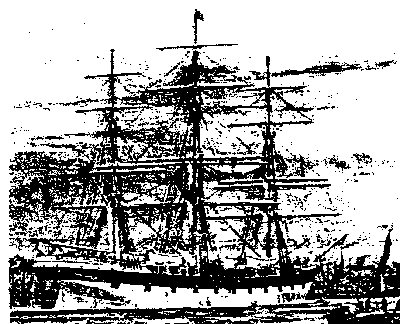 |
FAMOUS SHIPS |
 |
FAMOUS SHIPS |
THE "WESTLAND "
The WESTLAND was always considered the fastest vessel belonging to Shaw Savill & Albion Co., and was the last sailing ship built for the firm. She was also the last sailing ship built specifically to carry passengers out to New Zealand. She registered 1,116 tons and her dimensions were: length, 222 feet 8 inches; breadth, 35 feet 1 inch; depth, 21 feet. Originally, she carried royals over single topgallants but in 1904 she was cut back to barque-rig to save expenses.
One of the main reasons that the Shaw Savill & Albion Co. was so successful was due to the builder of their ships, the Glasgow shipbuilder, Robert Duncan. His last ship built for them was the WESTLAND, launched in October 1878.
During her long career under the Shaw Savill & Albion house flag, the WESTLAND made twenty-five voyages out to New Zealand. Fourteen of these were to Port Chalmers, five to Wellington, three to Nelson, two to Lyttelton, and one to Buff Harbor. Her best outward passage was made in 1888, when, under Captain Scotland, she reached Dunedin 73 days out from London. The Otago Daily Times, in referring to the passage, said: "Her advent was unexpected, the vessel not being due for at least another week. Captain Scotland was heartily congratulated on having made the shortest passage of any sailing vessel."
She made a smart homeward passage this same year, sailing from the port on August 14th, 1888, and arriving at Falmouth on November 6th , 84 days out. Once discharging her cargo in the Thames, she loaded 600 tons of cement as stiffening, sailed to Glasgow, loaded 1,800 tons of general cargo and sailed for Port Chalmers. Although the passage took 72 days due to some thick, dirty weather encountered off the New Zealand coast, Captain Scotland was still congratulated on still another record, for between the date he left Lyttelton and that on which he arrived in Port Chalmers only 6 months and 23 days had elapsed.
Captain Kelly made another smart voyage in this
beautiful little clipper in 1894-5. Although her London to Port Chalmers passage was made
in 90 days, only an average passage for the speedy little ship, it was a noteworthy
passage due to the excellent twenty-four hour runs she had while on this passage. While
running the Roaring Forties, she had runs of 342, 340 and 330 miles. After discharging,
she left Dunedin for Bluff, in order to load wool cargo. Here she had to wait six months,
and when she finally got away she was the last vessel in a fleet of twenty wool clippers
to leave New Zealand. Yet, she arrived in the Channel 22 days before any of the ships that
had left ahead of her. Her time to London was given as 72 days.
The WESTLAND kept free from accident and seems to have been a very lucky ship. Her worst adventure was on her outward passage to Wellington in 1895, when she encountered what might be described as a hurricane to the southward of the Cape. The ship was hove-to for 16 hours, during which time mountainous seas swept over her weather-rail and so damaged the vessel forward, carrying away the jib-boom, the fo'c'sle-rail, and starting the fo'c'sle deck, that Captain Kelly was at last forced to set his foresail and square away before the north-west wind. Luckily for those on board, the foresail held, although while the ship was hove-to her fore topmast staysail had been blown to ribbons and the stout main lower topsail of storm canvas was also blown out of the bolt ropes. Whilst the ship was running before the mountainous seas she received further damage, being swept from stem to stern. The forward boats were smashed, the skids broken down, fo'c'sle and midship-house doors torn from their hinges, the topgallant-fo'c'sle ladders washed away, and, on the poop, the binnacle damaged and the compass put out of action. However, the WESTLAND survived and duly reached Wellington on September 17"', 96 days out.
The WESTLAND had a number of commanders. Her first commander, Captain Wood, sailed her on her maiden voyage to Port Chalmers in 80 days. His second outward passage was 88 days to Lyttelton. Then Captain Moffatt had the little ship for four voyages, his best passage being one of 79 days to Wellington, which was reached on January 1, 1883. Captain McWilliams was next. His first passage was 78 days to Port Chalmers. On his second passage Captain McWilliams made the remarkable record in the Roaring Forties of sixteen days between the Cape of Good Hope and Shag Point. He was succeeded in 1887 by Captain Scotland, who had the ship for three voyages and seems to have the best record of all her captains. He, in turn, was followed by Captain Metters, who made three voyages in the ship between 1890 and 1892. Then came Captain Kelly. He had the ship for six voyages and died aboard, whilst outward bound on his seventh, in 1900. When Captain Kelly died, he was succeeded by his chief officer, Captain Samuel, who remained in command until 1905. Her last commander under the house flag of Shaw Savill & Albion was Captain James, who sailed her to Nelson in 99 days, arriving on November I I"', 1906. On her arrival home at the end of this voyage she was sold to C. Hannevig, of Norway, but did not last long under her new owners. In December 1909, she put into Kingston, disabled, from Barbados, and here she was condemned and broken up.